Heavy twin-engined Japanese fighters versus American bombers
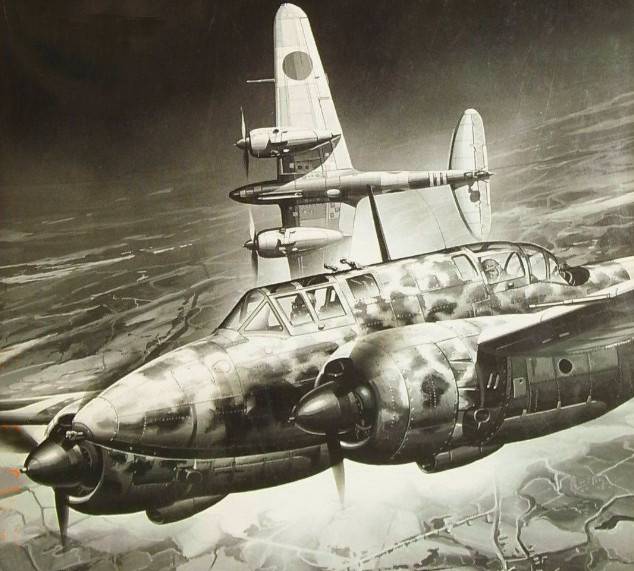
In the pre-war period, the concept of a heavy escort fighter with two engines was quite fashionable. However, the actual course of hostilities has shown that twin-engine fighters are themselves very vulnerable to attacks from more maneuverable and high-speed light single-engine fighters. In this regard, already produced heavy fighters with two engines were mainly used as light high-speed attack bombers and as night fighters.
Ki-45 Toryu heavy fighter
Testing of the Ki-45 Toryu began in 1939, and at the end of 1941 this heavy fighter was put into service. The aircraft of the first production modification Ki-45Kai-a were equipped with two 14-cylinder air-cooled Ha-25 engines with a capacity of 1000 hp each. from. From the end of 1942, more powerful 14-cylinder air-cooled engines Ha-102, 1080 hp each, began to be installed. from.
The offensive armament consisted of two fixed 12,7 mm machine guns mounted in the nose of the fuselage and one 20 mm cannon in the lower fuselage. At the disposal of the radio operator was a turret 7,7-mm machine gun for firing backwards. Approximately two dozen heavy fighters in the field were modified to fight enemy bombers at night. Instead of an upper fuel tank, two 12,7 mm machine guns were placed in the fuselage.
Taking into account that 20-mm cannon and a pair of 12,7-mm machine guns were not enough to confidently defeat a heavy bomber, several Ki-45Kai-b aircraft armed with 37-mm tank cannon Type 98. aviation By the standards, this weapon had high ballistic characteristics. A high-explosive fragmentation projectile with a mass of 644 g left the barrel with an initial speed of 580 m / s and had an effective range of up to 800 meters. The only question was the accuracy of targeting and the probability of hitting with one shot. The gun was loaded manually by a radio operator. And due to the low rate of fire, its effectiveness was low.
At the end of 1943, serial production of the Ki-45Kai-c began with the 37mm Ho-203 automatic cannon. This gun had a rate of fire of 120 rounds / min. The initial velocity of the projectile is 570 m / s, the effective range is up to 500 m, the ammunition load is 15 rounds. The 37 mm cannon was installed instead of the front 12,7 mm machine guns, the 20 mm cannon at the bottom of the fuselage was retained.
In 1944, production of the Ki-45Kai-d night fighter began, on which, instead of a 20-mm cannon, two 32-mm cannons were installed in the fuselage, directed forward and upward at an angle of 20 °. The rear defensive machine gun on this modification was dismantled.
At the end of 1944, several Ki-45Kai-e night interceptors with Taki-2 radar were launched. Due to the fact that the radar equipment took up a lot of space, this aircraft had only one 40 mm Ho-301 cannon with 10 rounds of ammunition.
The most popular were the Ki-45Kai-c (595 units) and Ki-45Kai-d (473 units). Aircraft of these modifications practically did not differ in flight data. An aircraft with a normal takeoff weight of 5500 kg at an altitude of 6500 m in horizontal flight could accelerate to 547 km / h. Ceiling - up to 10000 m. Practical range - 2000 km.
For an aircraft of this size and specific purpose, the Ki-45 was built in fairly large series. Taking into account the experimental and pre-production vehicles, more than 1939 units were produced from 1945 to July 1700. The main disadvantage of all Ki-45s when used as an interceptor was the insufficiently high flight speed. This twin-engine fighter could attack B-29s cruising at economical speed. After the discovery of the Toryu, the pilots of the Superfortress gave full throttle and broke away from the Japanese heavy fighters. Due to the inability to attack again, in early 1945, Japanese pilots flying the Ki-45 began to use ram attacks.
J1N Gekko Heavy Night Fighter
In parallel with the Ki-45 Toryu, created at the Kawasaki company, the Nakajima company based on the terms of reference issued by the command fleet, developed another heavy fighter intended to escort land-based torpedo bombers and naval aviation bombers.
When this aircraft was already created, the Japanese admirals came to the conclusion that the heavy twin-engine aircraft was unlikely to be able to withstand light interceptors in maneuverable combat. And the problem of covering the bombers was partly solved by using outboard fuel tanks on single-engine fighters. However, the plane itself was not abandoned. And they retrained him as a distant scout. Serial production of the aircraft, designated J1N-c Gekko (also known as the Type 2 Marine Reconnaissance Aircraft), began in December 1941. It was officially adopted by the Navy in July 1942.
The aerial reconnaissance aircraft with a maximum takeoff weight of 7 kg had good data for a vehicle of this class. Two engines with a capacity of 527 hp from. each, provided a speed in horizontal flight of up to 1 km / h, a flight range of 130 km (up to 520 km with outboard tanks).
In the spring of 1943, the commander of one of the units armed with J1N1-c reconnaissance aircraft suggested converting this aircraft into a night fighter. In the field workshops, on several aircraft in the navigator's cockpit, two 20-mm cannons were installed with a 30 ° forward-upward tilt and two more - with a downward tilt. The converted aircraft received the designation J1N1-c Kai. Soon, the improvised interceptors achieved their first victories, they managed to shoot down and seriously damage several B-24 Liberator bombers. The success of the experiment, as well as the awareness of the need for night fighters, prompted the command of the fleet to issue the Nakajima firm with the task of starting the production of night interceptors. The production of Gecko fighters continued until December 1944. A total of 479 aircraft of all modifications were built.
Production of the night fighter, designated J1N1-s, began in August 1943. The aircraft's armament was similar to the J1N1-c KAI, but taking into account the intended purpose, some changes were made to the design. Combat experience showed the ineffectiveness of cannons that fired downward, so over time they were abandoned. These machines were designated J1N1-sa.
Some of the fighters were equipped with radar with an antenna in the bow. FD-2 and FD-3 radars were installed on Gekko heavy fighters. Radars of this type operated in the 1,2 GHz band. With a pulse power of 1,5–2 kW, the detection range was 3–4 km. Weight - 70 kg. In total, no more than 100 stations were manufactured. Searchlights were installed on other interceptors in the bow. Sometimes, instead of a locator or searchlight, a 20-mm cannon was placed in the bow. The cannons and radar antennas worsened aerodynamics, so the maximum flight speed of these night interceptors did not exceed 507 km / h.
After the Japanese troops left the Philippines, the surviving J1N1-s heavy fighters were relocated to Japan, where they were included in the air defense units. The relatively low speed did not allow the Gekko pilots to re-attack the B-29, and therefore often rammed. At the end of the war, most of the surviving Gekko were used as kamikaze.
Heavy fighter Ki-46
Another heavy Japanese heavy fighter converted from a reconnaissance aircraft was the Ki-46-III Dinah. The reconnaissance aircraft with a normal takeoff weight of 5800 kg was originally equipped with 1000 hp engines. from. and in horizontal flight it could accelerate to 600 km / h. This aircraft was put into service in 1941 and initially received the army designation Type 100, in combat squadrons it was called Ki-46. To protect against fighter attacks, the radio operator had a rifle-caliber machine gun at his disposal.
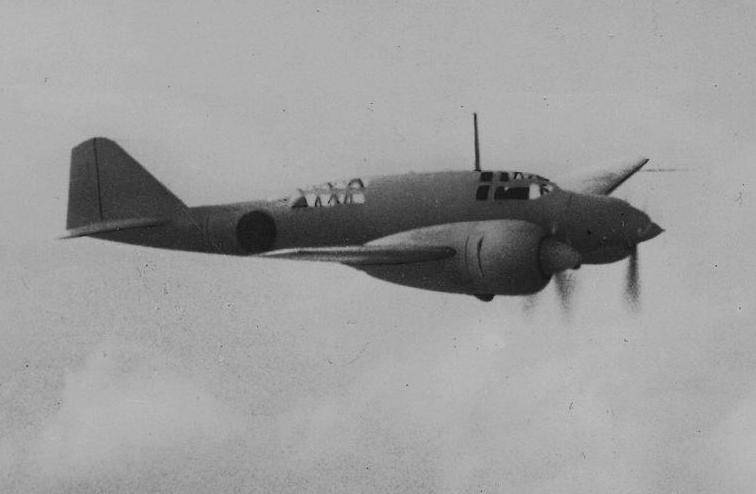
Air reconnaissance Type 100
In 1942, the Type 100 reconnaissance aircraft was one of the fastest aircraft in the army aviation. In this connection, it was decided to adapt it to intercept American bombers. Initially, the command of the imperial army could not find anything better than to install a 46-mm Type 37 tank gun in the nose of the Ki-98-II modification aircraft. The first prototype of the cannon "Dina" was ready in January 1943. The tests were deemed satisfactory, after which 16 more such machines were built. These aircraft were sent to reinforce the Japanese aviation group in New Guinea, but they did not achieve much success there.
Due to the acute shortage of high-speed interceptors, in February 1943, Ki-46-II scouts were first equipped with Ta-Dan cluster bomb holders, which contained 30-76 Type 2 HEAT fragmentation bombs. This made it possible to use unarmed reconnaissance as interceptors. And in the future, "air bombs" were used until the end of the war.
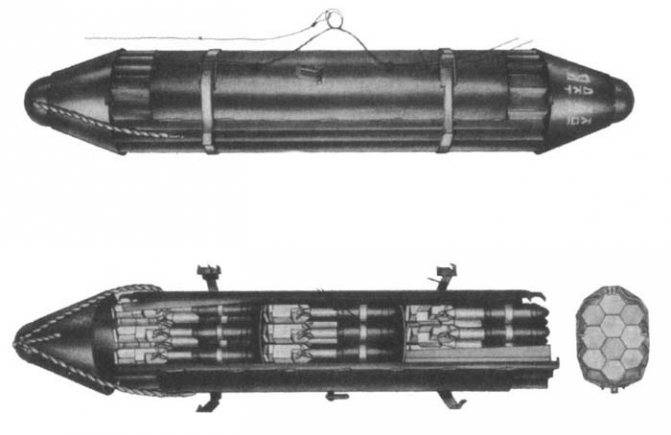
Bomb cassette Ta-Dan
Containers, however, like bombs, were developed primarily for use against enemy bombers, although they were allowed to be used against ground targets. The total weight of the containers was 17–35 kg. The Type 2 bomb weighed 330 g and contained 100 g of a mixture of TNT and RDX. The bomb had an elongated aerodynamic shape. In the bow there was a cumulative notch.
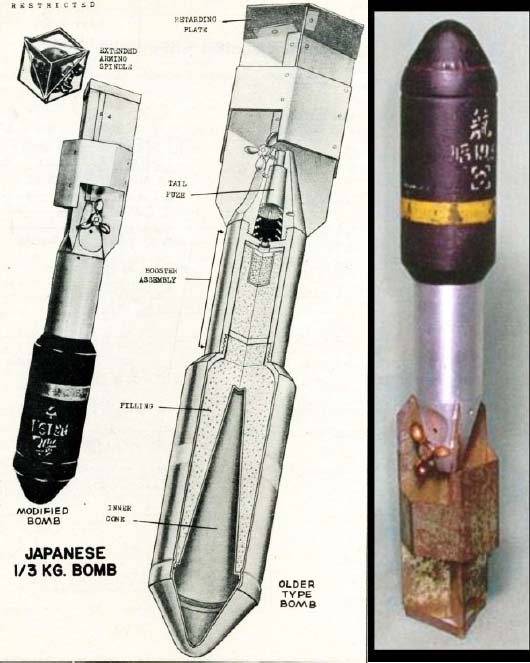
The bomb fuse was located in the tail section between the stabilizers and could be set to shock or detonate after a certain time after the release (5-30 s). This bomb had excellent aerodynamics. The trajectory of its flight and, accordingly, the direction of the main force of the explosion were strictly parallel to the velocity vector, which greatly facilitated aiming.
Theoretically, a bomb attack from the rear hemisphere looked the most preferable, however, in practice, Japanese fighter pilots were too vulnerable to fire from tail gunners. In this regard, high-altitude bombing tactics were used against a dense formation of bombers. At the same time, the excess of Japanese fighters flying in parallel courses over the formation of bombers did not exceed 800 m.
However, before dropping the cassettes, it was necessary to accurately determine the lead, which was very difficult. In addition, at the time of the drop, the target was outside the space visible to the pilot of the fighter. In this regard, several other methods of using "air bombs" have been developed.
One of the early tactics involved an attack from a frontal direction exceeding 1000 meters. At a distance of 700 meters from the attacked target, the pilot switched the fighter into a dive at an angle of 45 °, aimed at a standard rifle scope and reset the cassette.
By the time the massive B-29 raids on Japan began, the optimal tactics for using anti-aircraft bombs had been developed. Thus, the massive use of Type 2 bombs with remote fuses presupposed not so much the destruction of an enemy bomber as disorientation and blinding of the pilots and gunners of defensive installations. The attack was carried out from the frontal direction by the forces of several interceptors. The first two, armed with Ta-Dan cassettes, walked side by side, dropped their cargo and abruptly left in different directions - the left fighter banked to the left, the right one, respectively, to the right. The bombs exploded right in front of the formation of the attacked bomber. After which, as a rule, he broke down. And the shooters of different bombers could not provide mutual cover. For a while, the disoriented riflemen reduced the effectiveness of their deadly fire, and other Japanese fighters, taking advantage of this, attacked the Superfortresses using machine-gun and cannon armament.
Despite the rather active use of "air bombs", the results of their use were very modest. it weapon possessed a mass of shortcomings, could not compete with traditional small arms and cannon weapons and compensate for the obvious weakness of the Japanese fighter aircraft.
Taking into account the German experience, unguided aircraft missiles with fragmentation warheads equipped with fuses programmed to detonate after a certain time interval could be effective against large groups of B-29s. Such missiles had a simple design and, given the fairly dense military-technical cooperation between Germany and Japan, they could be quickly mastered in production. However, nothing is known about the massive use of such weapons by the Japanese in combat conditions.
In the late autumn of 1944, when the territory of the Japanese metropolis began to be subjected to the methodical raids of the Superfortresses, a full-fledged interceptor was created on the basis of the Ki-46 reconnaissance aircraft. In November 1944, 46 mm No-46 automatic cannons were installed on six Ki-37-II and one Ki-203-III in the field workshops. The guns were placed in the rear scout cabin at an angle of 75 ° forward and upward. For the first time, improvised interceptors went into battle on November 24, 1944.
Against the background of a total shortage of fighters capable of counteracting the devastating raids of the B-29, a large-scale conversion of scouts into heavy fighters was carried out at repair enterprises and factory facilities.
interceptors.
Ki-46-III Kai, equipped with two 1500 hp engines. with., had a normal take-off weight of 6228 kg. The practical flight range reached 2000 km. Service ceiling -10500 m. According to reference data, this model in level flight could reach a speed of 629 km / h. But, apparently, such altitude and speed characteristics are fair for an unarmed scout. And the installation of weapons could not but worsen the flight data.
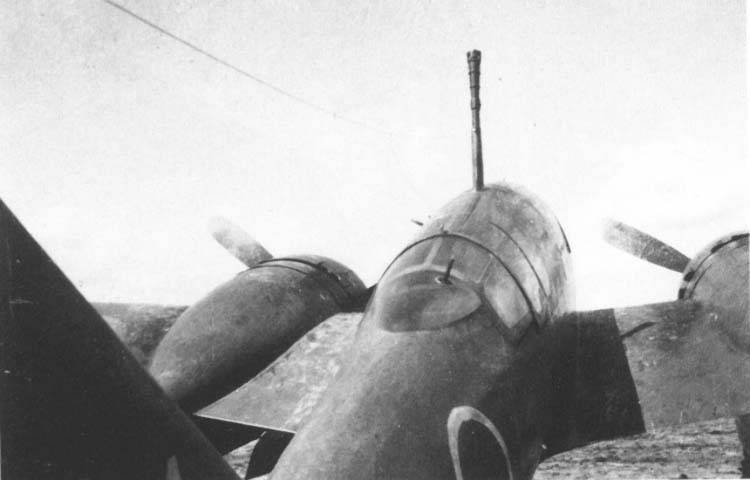
In addition to the interceptor with a 37 mm gun on the back, the Ki-46-III Kai-Otsu was produced, armed only with a pair of 20 mm cannons in the bow. There was also a "mixed" modification of the Ki-46-III Kai-Otsu-Hei with 20mm and 37mm cannons. However, this model did not become widespread, since the increased firepower caused a significant drop in flight speed.
In total, approximately 1800 aircraft of the Ki-46 family were built. How many of them were converted into interceptors or immediately built in a fighter modification, it was not possible to establish.
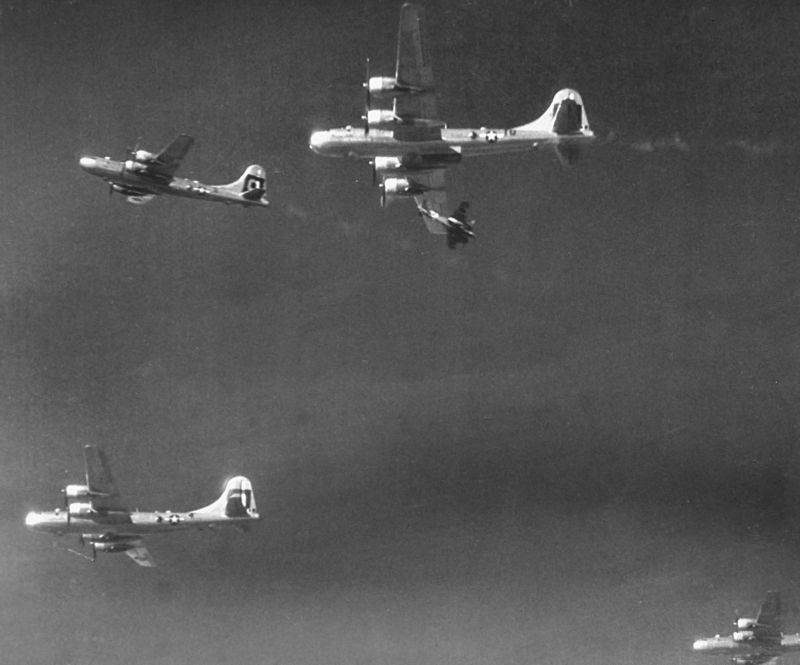
Heavy fighter Ki-46 attacking B-29
Assessing the results of the use of a high-speed reconnaissance aircraft in an unusual role of a fighter-interceptor, we can say that the fighter versions of the Ki-46-III Kai were nothing more than a forced improvisation designed to plug a gap in the Japanese army aviation. "Dina" was a very good high-altitude and high-speed reconnaissance aircraft, but her fighter turned out to be very mediocre: with a low rate of climb, low survivability and weak armament.
The Ki-46-III Kai-Otsu-Hei version with the 37mm cannon was too inert and heavy, and the more numerous Ki-46-III Kai-Otsu, armed with only two 20mm cannons, were too much to fight the B-29. low-power.
The effectiveness of Japanese fighters against B-29 bombers
Taking into account the acute shortage of high-speed fighters with powerful weapons capable of confidently intercepting the B-29, the Japanese actively used air rams when repelling the raids of the Super Fortresses.
At the same time, unlike the "kamikaze" attacking the warships of the allies, the pilots of the Japanese fighter-interceptors were not suicides. They were tasked with surviving as much as possible. Sometimes, after a ramming strike, Japanese pilots succeeded not only in jumping out with a parachute, but also successfully landing a damaged fighter. So out of ten Japanese aircraft that rammed their opponents on January 27, 1945, four pilots escaped with parachutes, one brought his plane back to base and five were killed.
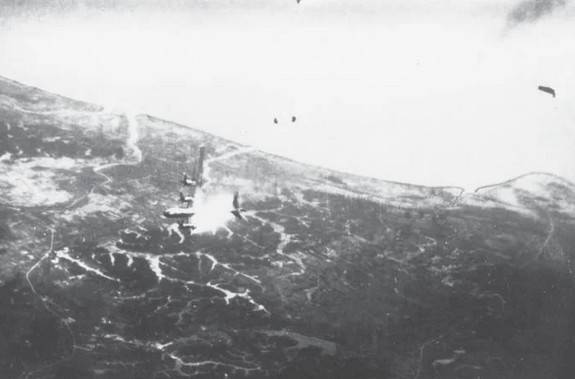
B-29 destroyed by ramming
At the initial stage, such tactics gave certain results, and the losses of the B-29 in the first raids on the Japanese islands were very sensitive.
The loss data reported by the parties varies greatly. According to information published in publicly available sources, a total of 414 "Superfortresses" were lost, of which only 147 had combat damage. At the same time, the Americans admit the loss from the actions of 93 B-29 fighters.
The pilots of the Japanese fighters announced the destruction of 111 heavy bombers only by ram attacks. In total, according to the Japanese side, more than 400 V-29s were destroyed by air defense forces. In the course of repelling the B-29 raids, the Japanese aviation lost approximately 1450 fighters in air battles. And about 2800 more aircraft were destroyed during the bombing of airfields or died in flight accidents.
Apparently, American statistics only take into account bombers shot down directly over the target. The crews of many B-29 bombers damaged by Japanese air defense could not reach their airfields, some of them crashed during an emergency landing. And the actual losses of bombers from Japanese fighters were greater.
On the other hand, the "Superfortresses" often demonstrated miracles of combat survivability, and in some cases returned to their airfields, having received very heavy damage.
So, on January 27, 1945, during a raid on an aircraft engine plant in the vicinity of Tokyo, B-29 with number 42-65246 was fired on and twice rammed. The Japanese fighters that rammed the Superfortress crashed, and the bomber, which several Japanese pilots were claiming to shoot down, was able to return to its base. During landing, the B-29 broke, but its crew survived.
Quite often, bombers returned from raids with damage caused by anti-aircraft artillery, as well as by the weapons of Japanese interceptors.
So, B-29 No. 42-24664 of the 500th bomber group landed on Iwo Jima, two engines of which on the night of April 13, 1945 were disabled by fighters over Tokyo. When landing, the plane rolled out of the runway and crashed into a stationary car.
Another example of phenomenal combat survivability is B-29 No. 42-24627, which received more than 18 hits on April 1945, 350 during the bombing of Japanese airfields in Kyushu. Surprisingly, none of its crew was injured, the plane was able to return home and land.
In all three cases, heavily damaged aircraft were written off, but they were not included in combat losses. However, no matter how the Americans manipulated the statistics of losses, the US aviation industry easily made up for them.
Deprived of access to raw materials and exhausted by the war, Japan did not have such an opportunity. By May 1945, the resistance of the Japanese fighter aircraft was almost completely broken, and in July the B-29 groups operated practically unhindered. The destruction of airfields, fuel supplies, as well as the death of the best pilots in battles in the air and on the ground, put Japanese fighter aircraft on the brink of collapse. It all boiled down to individual attacks against armada of heavy bombers, which basically ended in the destruction of the attackers.
By that time, the number of combat-ready Japanese fighters was estimated at no more than 1000 aircraft. And in the conditions of air superiority of enemy aviation, they could do little. Although the B-29 suffered losses until the end of hostilities, they were mainly caused by anti-aircraft artillery, associated with equipment failure or pilot errors.
The surviving Japanese fighter pilots were unable to counter the Superfortresses' attacks and were ordered to keep the remaining aircraft in reserve for the final battle expected in the fall. Japan's air defense has been weakened to a critical level. In addition to the shortage of fighter-interceptors and trained pilots, there was a shortage of radars and searchlights.
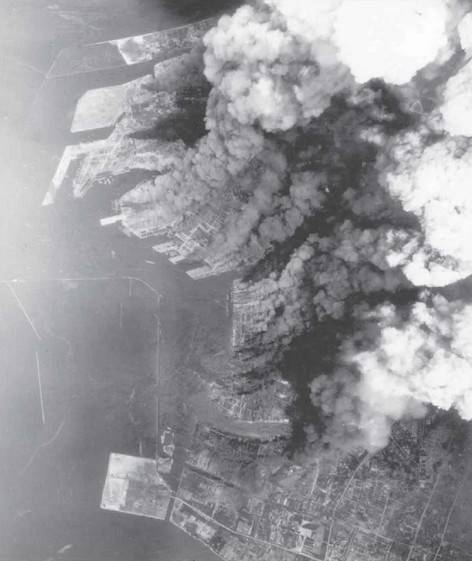
So on June 1, 1945, after the B-29 raid, the port of Osaka looked from the air
By August 1945, Japan's industry was in ruins, and many of the residents who survived the massive raids of the Superfortresses were left homeless. Despite this, most of the ordinary Japanese were ready to fight to the end, but their spirit was largely undermined. And a very significant part of the population understood that the war was lost.
Thus, the Boeing B-29 Superfortress bomber became one of the decisive factors in the US victory, which made it possible to achieve the surrender of Japan without landing on the islands of the mother country.
To be continued ...
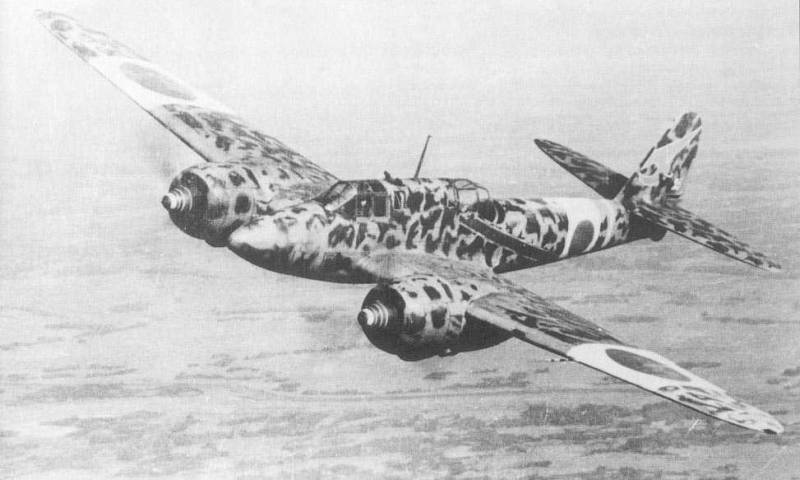
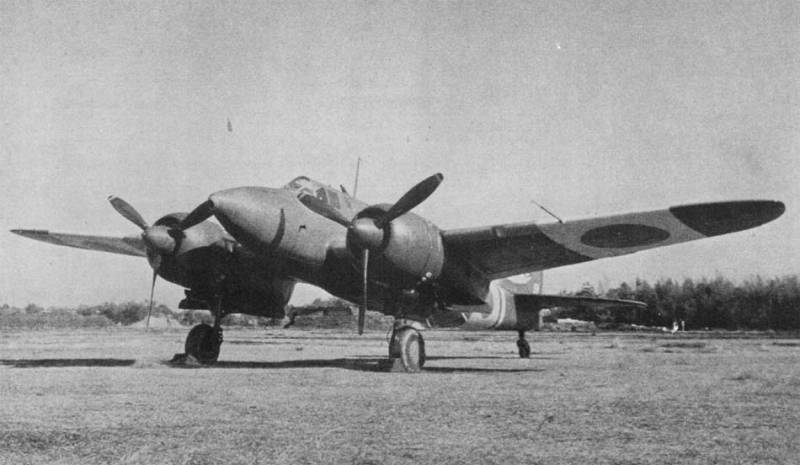
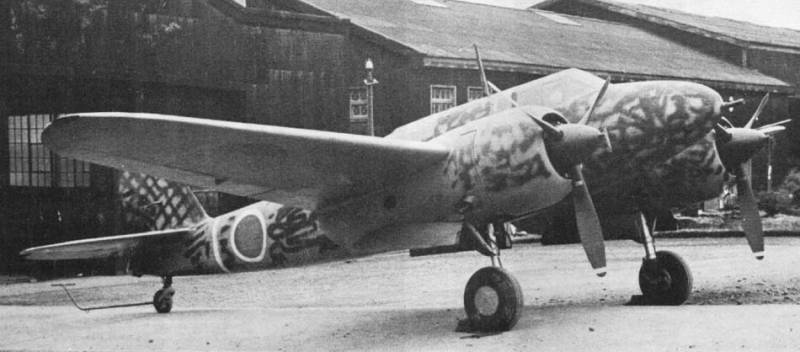
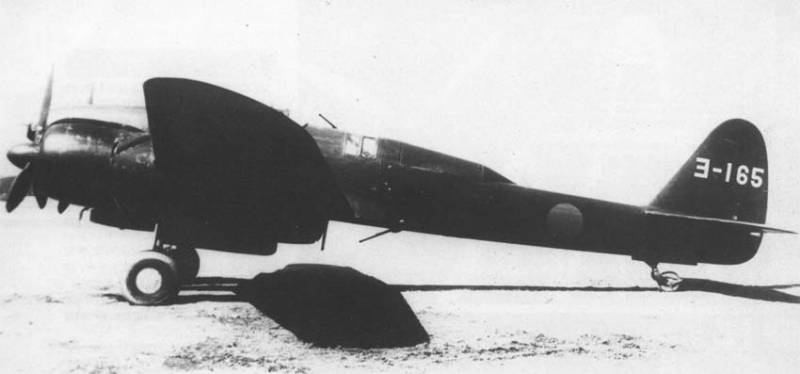
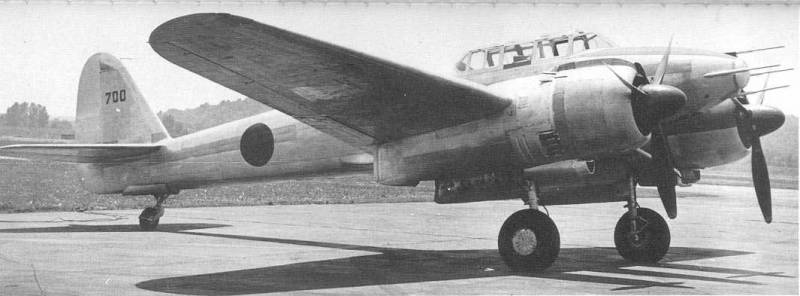
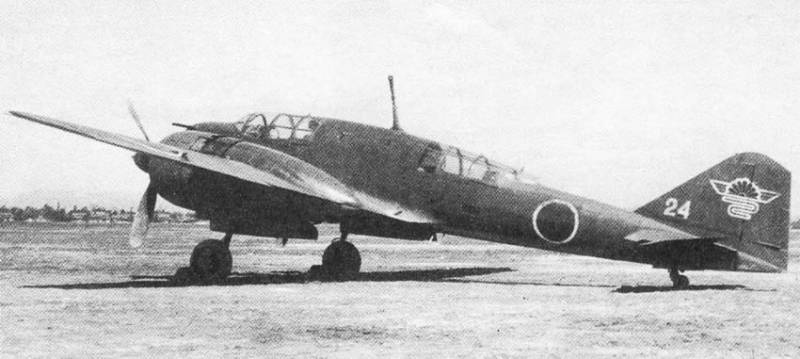
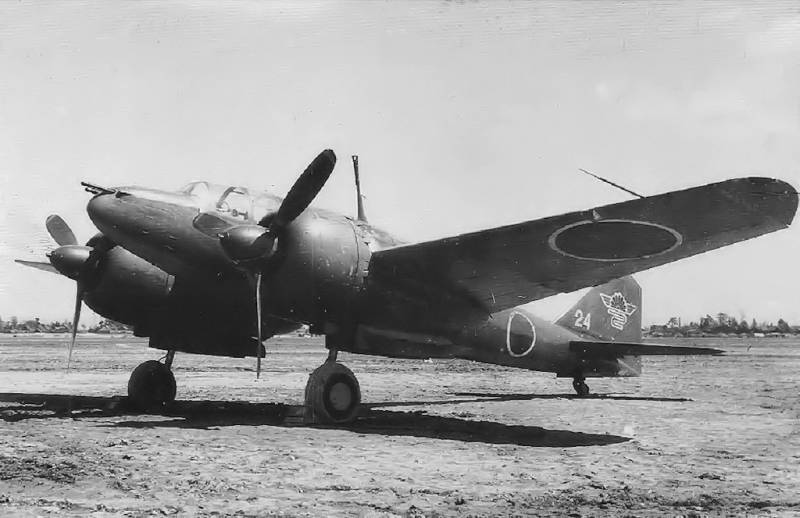
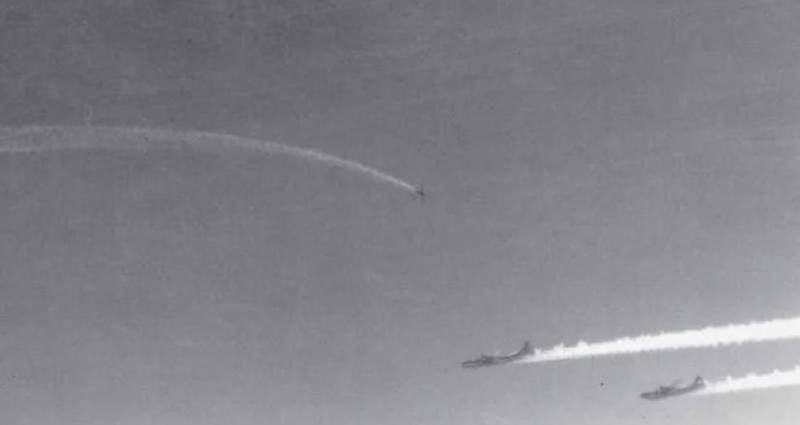
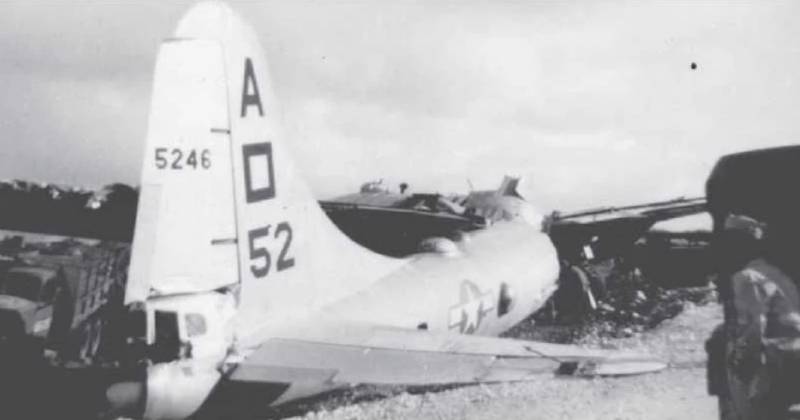
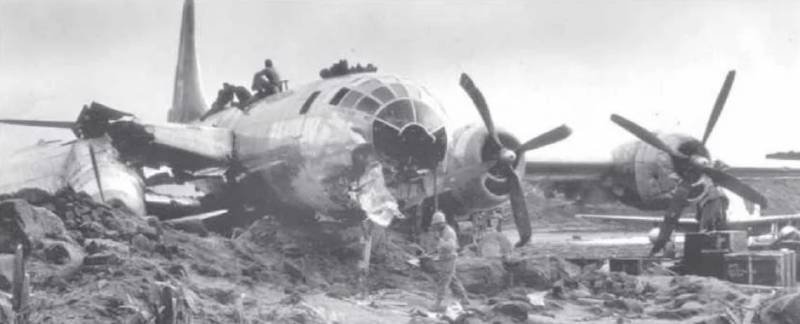
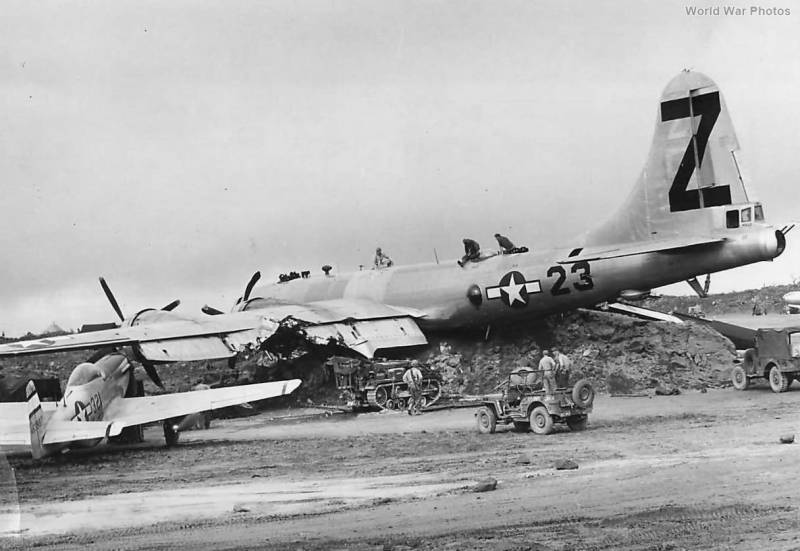
Information